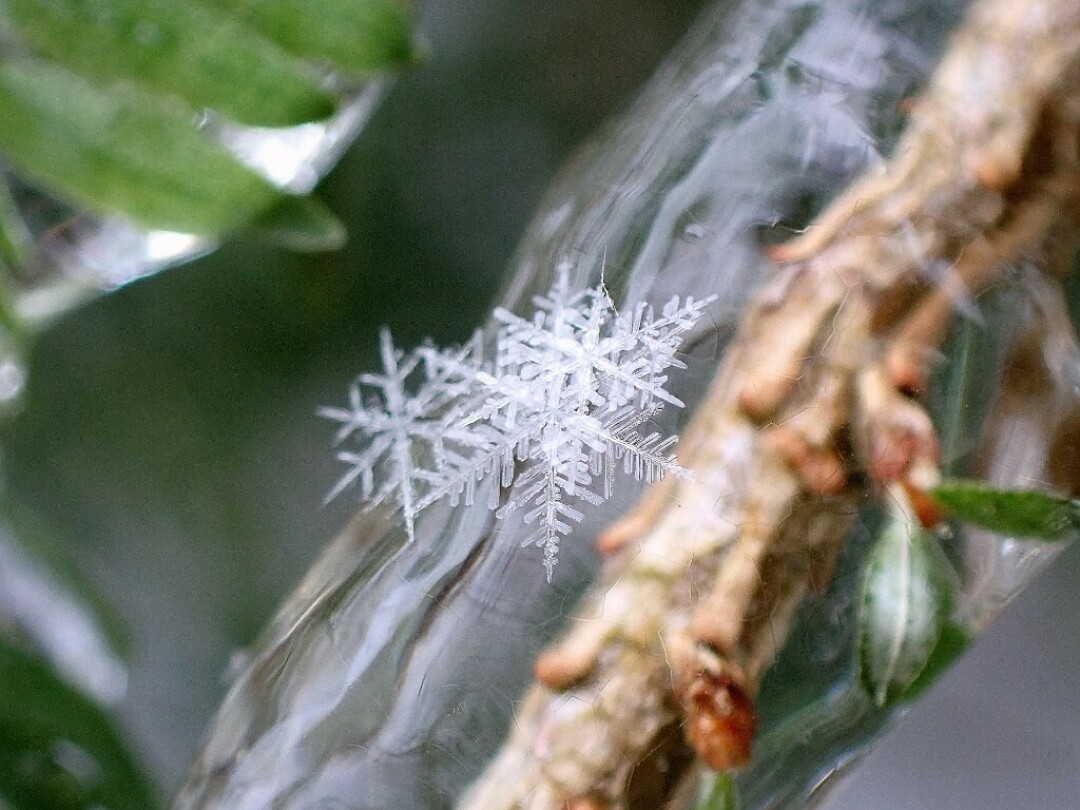News & Articles
Browse all content by date.

“Snowflakes are amazing!” I gushed to the students in a recent “Words for Winter Wonder” writing workshop hosted by the Lake Superior Writers in Duluth.
I continued on, summarizing how snowflakes form. Water vapor crystalizes around a piece of dust, or dirt or even a unique bacterium.
Then, as puffs and gales of wind toss the nascent snow crystal inside a cloud, they experience varied combinations of temperature and humidity.
The crystal grows differently in each new habitat. One environment produces simple hexagonal prisms. Another combination of characteristics builds beautiful branches. A snow crystal grown in just one habitat might be pretty basic, but the ones who cause us to gasp at their beauty when they land on our sleeve have traveled far and wide.
I clicked to the next slide, and a video of a single snow crystal growing in a science lab shone on the screen. The delicate beauty, even translated through all of that technology, was stunning.
“Now, we get to try to imitate that beauty that comes with variety,” I said as I passed out a different color of paper to each of the six students. How fitting, I thought, to have six students to imitate the six-sided snow crystals.
Each person wrote a single sentence (sometimes two, it’s hard to reign in writers) at the top of their paper. The instruction was simply to “set the scene.”
When I told the students to crumple their paper into a ball, there was some worried chuckling. That turned to laughter when I yelled “snowball fight!” and the paper balls went flying across the room.
Each student picked up a ball that wasn’t their own, and now I added a new element to their environment.
“Add the next sentence to the story on your new paper, but this time include visual descriptions, your sense of sight.”
We wrote, crumpled, tossed and flattened the papers over and over, adding sentences about touch, smell and finally a conclusion.
Then each student read aloud the story contained on their final (very wrinkled) paper.
The resulting winter vignettes were almost as beautiful as snow crystals formed high in a winter cloud. The tone for each one had been set by the original writer, and (just like with a growing snow crystal!) the subsequent additions were a mix of sticking to the story and adding each writer’s own flare. I’d like to share a few of them with you here.
1. The late afternoon sun lingered on the horizon, casting long shadows over the ice. No snow had yet fallen over the bubbled blue of new ice. The weak yellows of the sun barely colored the landscape. She lay on the smooth ice, feeling the frigid cold beneath her, staring below. The scent of dry leaves blew out from shore, but beneath that the air was clean, crisp, promising snow to come. She looked forward to seeing the ground covered with its clean white equality.
2. She stepped out her door into the chill, quiet night to watch the first snowflakes of winter. Through the muffling of this snowfall, she heard the light crunch of footsteps. She imagined how it would feel to wear those boots, to sense the leaves crackle under her feet with the snowflakes dissolving cold on her skin. Woodsmoke from a nearby cabin mingled with the snow in her hair, releasing an earthy fragrance. She saw the kind face of her neighbor come to greet her to share in this delight.
3. Large puffs of snow drifted down around her as she walked along a winding winter path. Each branch caught the flakes and held them as their dark branches whitened. As she passed a railing, she ran her mitted hand along it, gathering the cool, light snow in her palm. The winter air smelled white, burning her nose, and she burrowed into her woolly scarf, inhaling her own warmth. She was content here, though in a moment she would turn away toward home.
4. The fox came into our yard quietly, cocking his head and stopping frequently. He rolled in the fluffy snow sending dried seed heads of spent wildflowers flying into the air. The fox shook his fur as the seeds tickled his whiskers – enough playing around! He stopped cold – a whiff of something travelling downwind – something warm, sweet and enticing. Ah, a mouse nest under the snow, and a well-aimed pounce on winter snack!
As with snow crystals, no two snowflake stories will ever be just alike, and their beauty is a reflection of the community who created them.
Thanks to my students for allowing me to share their stories with you!
Emily Stone is Naturalist/Education Director at the Cable Natural History Museum. Her award-winning second book, Natural Connections: Dreaming of an Elfin Skimmer, is available to purchase at cablemuseum.org/books and at your local independent bookstore, too. For more than 50 years, the Cable Natural History Museum has served to connect you to the Northwoods. Our exhibit: “The Northwoods ROCKS!” is open through mid-March. Our Winter/Spring Calendar of Events is ready for registration! Follow us on Facebook, Instagram, YouTube, and cablemuseum.org to see what we are up to.
| Tweet |


